Twinhead TKI400ABGSG22 12.1” Tablet PC User Manual SG22
Twinhead International Corporation 12.1” Tablet PC SG22
Twinhead >
Manual
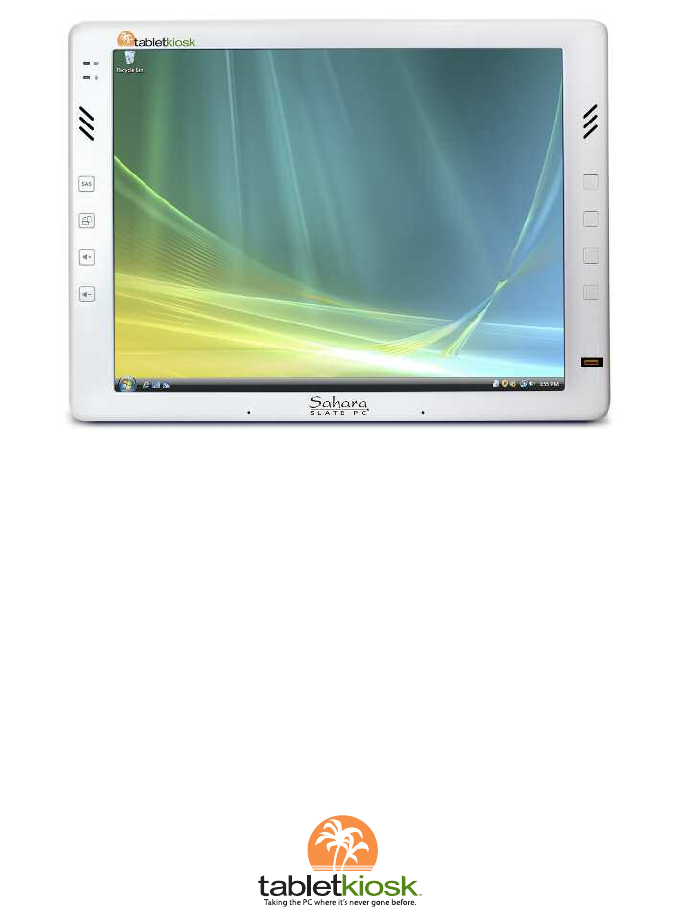
User’s Guide
Sahara Slate PC® i400 Series
Tablet PC

Chapter 00: Preface i
Reading this manual will help you get the most out of your new
Sahara Slate PC. If you are a new computer user, or just new to
Tablet PCs, you should read through the manual carefully before
first using your new Sahara Slate PC.
Visit us online at www.tabletkiosk.com for additional resources
and information to help you get the most from your Sahara Slate
PC i400 Series Tablet PC.
Copyright
©2007 Sand Dune Ventures, Inc. All Rights Reserved. All product
information is subject to change without notice. Sahara Slate PC
is a registered trademark and TabletKiosk is a trademark of Sand
Dune Ventures, Inc.in the United States and/or other countries.
Microsoft, Windows XP, Windows Vista and the Windows logo are
either registered trademarks or trademarks of Microsoft
Corporation in the United States and/or othercountries. Intel,
Core, Centrino Duo, Celeron, Core Duo Inside logo, Celeron
Inside logo and Centrino Duo Inside logo are trademarks or
registered trademarks of Intel Corporation in the United States
and/or othercountries. The Bluetooth® word mark and logos are
owned by the Bluetooth SIG, Inc. and any use of such marks by
TabletKiosk is under license. Linux is a registered trademark of
Linus Torvalds.
Chapter 00
Preface
ii Chapter 00: Preface
Disclaimer
The specifications and information in this manual are subject to
change without prior notice in order to improve reliability,
design and/or function, but this does not represent a
commitment on the part of the manufacturer. The manufacturer
assumes no responsibility for errors or omissions in this
document.
In no event will the manufacturer be liable for direct, indirect,
special, incidental, or consequential damages arising out of the
use, or inability to use, the Tablet PC or this documentation, even
if advised of the possibility of such damages.
This document contains proprietary information protected by
copyright. All rights are reserved. No part of this manual may be
reproduced by any mechanical, electronic, or other means in any
form without prior written permission of TabletKiosk.
If you have any questions regarding the Sahara Slate PC, or the
information contained within this manual, please contact
TabletKiosk at info@tabletkiosk.com.
Safety Instructions
For your safety and that of your equipment, please follow these
rules for handling and care of your Sahara Slate PC. Keep this
User’s Manual handy for later reference by you and other users.
Never use sprays, liquids or cleaning detergents for cleaning the
Sahara Slate PC Tablet. Use a micro fiber cloth for cleaning the
touch screen. Avoid the use of tissue paper since the tissue fibers
can easily lodge between the touch screen and the top cover of
the tablet.
Never pour liquids into any openings or directly on the Sahara
Slate PC. This could result in fire or electrical shock.
Ensure the voltage range of the power outlet is between 100V
and 240V before connecting the Sahara Slate PC. Exceeding the
Chapter 00: Preface iii
maximum rated voltage may cause damage to the AC adapter or
to the Sahara Slate PC. This could result in fire or electrical shock.
When the AC adapter is plugged into an electrical outlet, place
the power cord so it will not be stepped or walked on. Do not
place objects over or on the power cord.
Use the Sahara Slate PC in a clean, dry, temperature controlled
environment. Do not use the Sahara Slate PC in areas of high
humidity, around water or outdoors while it is raining.
Never open or disassemble the Sahara Slate PC. For safety
reasons, and to prevent permanent damage, the equipment
should only be repaired by qualified service personnel.
Contact a qualified service center if any of the following issues
should arise:
1. the AC adapter, power cord or plug is damaged
2. liquid has been spilled into the Sahara Slate PC
3. the Sahara Slate PC has been exposed to excessive moisture
4. the Sahara Slate PC exhibits errors and/or does not function
according to specifications
5. the Sahara Slate PC has been dropped or otherwise
physically damaged
Lithium batteries can be dangerous. There is a danger of
explosion if the battery is incorrectly replaced. Replace only with
the same or equivalent type recommended by the manufacturer.
Dispose of used batteries according to state or local hazardous
waste requirements.
Under no circumstances should the user attempt to disassemble
the power supply. The power supply has no user-replaceable
parts and its insides contain components that are electrically

iv Chapter 00: Preface
charged with hazardous voltage levels that can cause serious
personal injury. A defective power supply must be returned to
your dealer.
Safety Notices for the Power Cord
This equipment has a 2 or 3-wire power cord. Replace the power
cord if it becomes damaged. Contact your dealer for an exact
replacement.
In the U.S.A. and Canada, the power cord must be a UL-listed
detachable power cord (in Canada, CSA-certified).
2-wire cord SPT-2 18AWG
3-wire cord SVT or SJT, 18 AWG, 3-conductor
The cord should be provided with a molded-on cord connector
body at the other end. The cord length must not exceed 3
meters.
Outside the U.S.A. and Canada, the plug must be rated for 250
VAC, 2.5 amp minimum, and must display an international
agency approval marking. The cord must be suitable for use in
the end-user’s country. Consult your dealer or the local electrical
authorities if you are unsure of the type of power cord to use in
your country. Voltage changes occur automatically in the power
supply.
Notice of FCC Compliance
a. Federal Communications Commission (FCC) Requirements,
Part 15:
This equipment has been tested and found to comply
with the limits for a Class B digital device, pursuant to
Part 15 of the FCC Rules. These limits are designed to
provide reasonable protection against harmful
interference in a residential installation. This equipment
Chapter 00: Preface v
generates, uses, and can radiate radio frequency energy
and if not installed and used in accordance with the
instruction manual may cause harmful interference to
radio communications. However, there is no guarantee
that interference will not occur in a particular
installation. If this equipment does cause harmful
interference to radio or television reception, which can
be determined by turning the equipment off and on,
the user is encouraged to try to correct the interference
by one or more of the following measures:
Reorient or relocate the receiving antenna.
Increase the separation between the equipment and
receiver.
Connect the equipment into an outlet on a circuit different
from that to which the receiver is connected.
Consult the dealer or an experienced technician for help.
Use only shielded I/O cables to connect I/O devices to this
equipment.
You are cautioned the changes or modifications not
expressly approved by the party responsible for
compliance could void your authority to use the
equipment.
b. Regulatory information / Disclaimers
Installation and use of this device must be in strict
accordance with the instructions included in the user
documentation provided with the product. Any
changes or modifications (including the antennas)
made to this device that are not expressly approved by
the manufacturer may void the user’s authority to
operate the equipment. The manufacturer is not
responsible for any radio or television interference
caused by unauthorized modification of this device, or
vi Chapter 00: Preface
the substitution of the connecting cables and
equipment other than manufacturer specified. It is the
responsibility of the user to correct any interference
caused by such unauthorized modification, substitution
or attachment. Manufacturer and its authorized resellers
or distributors will assume no liability for any damage or
violation of government regulations arising from failing
to comply with these guidelines.
c. For portable devices without co-location condition (eg.
notebook pc)
FCC RF Radiation Exposure Statement:
1. This Transmitter must not be co-located or operating in
conjunction
2. This equipment complies with FCC RF radiation exposure
limits set forth for an uncontrolled environment. This device
was tested for typical lap held operations with the device
contacted directly to the human body to the back side of the
Tablet PC. To maintain compliance with FCC RF exposure
compliance requirements,please follow operation instruction
as documented in this manual.
d. SAR Exposure
This device has been tested for compliance with FCC RF
Exposure (SAR) limits in typical flat configurations.
In order to comply with SAR limits established in the
ANSI C95.1 standards, it is recommended when using a
Tablet PC that the integrated antenna is positioned
more than 1.5cm from your body or nearby persons
during extended periods of operation. If the antenna is
positioned less than 1.5cm from the user, it is
recommended that the user limit the exposure time.
For operation within 5.15 ~ 5.25GHz frequency range, it is
restricted to indoor environment.
Chapter 00: Preface vii
FCC Statement to Users for the FaxModem
This equipment complies with Part 68 of the FCC rules. On the
bottom of this equipment is the label that contains, among other
information, the FCC Registration Number and Ringer
Equivalence Number for this equipment. IF REQUESTED, THIS
INFORMATION MUST BE GIVEN TO THE TELEPHONE COMPANY.
The REN is useful to determine the number of devices you may
connect to your telephone line and still have all of those devices
ring when your telephone number is called. In most, but not all
areas, the sum of the REN’s of all devices connected to one line
should not exceed five (5.0).
To be certain of the number of devices you may connect to your
line, as determined by the REN, you should contact your local
telephone company to determine the maximum REN for your
calling area.
If your telephone equipment causes harm to the telephone
network, the telephone company may disconnect your service
temporarily. If possible, they will notify you in advance. But if
advance notice isn’t practical, you will be informed of your right
to file a complaint with the FCC.
Your telephone company may make changes in its facilities,
equipment, operations or procedures that could affect the
proper functioning of your equipment. If they do, you will be
notified in advance to give you an opportunity to maintain
uninterrupted telephone service.
The telephone company may ask you to disconnect this
equipment from the network until the problem has been
corrected or until you are sure that the equipment is not
malfunctioning. This equipment may not be used on coin service
provided by the telephone company.
viii Chapter 00: Preface
The Telephone Consumer Protection Act of 1991 makes it
unlawful for any person to use a computer or their electronic
device to send any message via a telephone facsimile machine
unless such message clearly contains in a margin at the top or
bottom of each transmitted page or on the first page of the
transmission the following information:
The date and time of transmission
Identification of either business, business entity or individual
sending the message;
Telephone number of either the sending machine, business
entity or individual.
In order to program this information into your fax/modem,
please refer to the appropriate instructions in your fax/modem
manual.
Note-TNV Safety Caution:
To reduce the risk of fire, use only No. 26 AWG or larger
telecommunication line cord. Avoid using a telephone (other
than a cordless type) during an electrical storm. There may be
a remote risk of electric shock from lightning. Do not use the
telephone to report a gas leak in the vicinity of the leak.
Canadian EMI Compliance Statement
This Class B digital apparatus meets all requirements of the
Canadian Interference - Causing Equipment Regulations.
IC Warning statement:
a. WLAN
“To prevent radio interference to the licensed service,
this device is intended to be operated indoors and away
from windows to provide maximum shielding.
Equipment (or its transmit antenna) that is installed
outdoors is subject to licensing.”
Chapter 00: Preface ix
b. For LPD
“Operation is subject to the following two conditions:
(1) this device may not cause interference, and (2) this
device must accept any interference, including
interference that may cause undesired operation of the
device.”
This Class B digital apparatus complies with Canada RSS-210.
The abbreviation, IC, before the registration number signifies
that registration was performed based on a Declaration of
Conformity (DoC) indicating that Industry Canada technical
specifications were met. It does not imply that Industry Canada
approved the equipment.
European Union CE Marking Declaration
This product has been tested and found to comply with the EMC
requirement subject to the EU directive for CE marking.
Radiation Exposure Statement:
This equipment complies with IC radiation exposure limits set
forth for an uncontrolled environment. End users must follow the
specific operating instructions for satisfying RF exposure compliance.
To maintain compliance with IC RF exposure compliance requirements,
please follow operation instruction as documented in this manual.
This page intentionally left blank.

Table of Contents xi
Getting Started 1
What’s in the Box 1
Setting Up Your Sahara Slate PC 2
Step 1: Inserting the Battery Pack 2
To Remove the Battery Pack 3
Step 2: Connecting the Tablet PC to an external power source 3
Step 3: Connecting applicable peripherals and
networking cables (optional) 4
Step 4: Powering on the Sahara Slate PC 4
Step 5: Navigating with the Stylus Pen 5
Touring Your Sahara Slate PC 9
Front View 10
Top View 12
Left Side View 14
Back View 16
Right View 18
Bottom View 18
Battery Usage and Care 21
Using the Battery for the First Time 21
Charging the Battery Under Typical Conditions 22
Problems Charging the Battery 23
Battery Status 23
Low Battery Warnings 23
About Battery Pack Usage 24
Real Time Clock Battery 24
Storing a Battery 25
Table of Contents
xii Table of Contents
Upgrading Your Sahara Slate PC 27
Before you Begin ANY Upgrade Procedure 27
Upgrading Memory (RAM) 28
Upgrading the Hard Disk Drive (HDD) 30
Replacing the Wireless Networking Card (Advanced) 32
Troubleshooting 35
General Hardware Problems / Possible Causes and Solutions 35
Audio Problems/Solutions 35
Battery Problems/Solutions 36
Internet Problems/Solutions 36
Networking Problems/Solutions 37
Power Problems/Solutions 37
Screen Display Problems/Solutions 38
USB Problems/Solutions 38
Upgrade Problems/Solutions 39
Contacting Your Dealer 40
Specifications 43

This page intentionally left blank.

Chapter 01: Getting Started 1
Your Sahara Slate PC was designed to allow you to get up and
running and quickly as possible. Due to the fact that the Sahara
Slate PC ships to various countries around the world, set-up may
vary slightly depending on where you are located.
If you have any questions that are not answered by this manual
to your satisfaction, please visit our website at
www.tabletkiosk.com for more information or to submit a
support request.
What’s in the Box
Your Sahara Slate PC should come securely packaged in its
shipping container along with the below listed items1. Please
contact your dealer immediately if you find that anything is
missing or damaged.
1. Sahara Slate PC i400 Series Tablet PC 2
2. Power Cord
3. AC Adapter
4. Slip Case
5. Simple Stand
6. User’s Manual, Utilities/Drivers Disc, System Restore Disc 3
7. Standard Lithium Ion Battery Pack
1Contents of the packaging may change without notice. Please check our
Chapter 01
Getting Started
2Chapter 01: Getting Started
website at www.tabkletkiosk.com for the most up-to-date list if your package
contents vary from this list.
2There are three models in the Sahara Slate PC i400 Series: i412T / i440T / i440D.
Please check to make sure you have received the correct model
3Please be sure to check that the System Recovery Disc matches the Operating
System (OS) preloaded on your Sahara Slate PC. There will not be a System
Restore Disc included if you ordered your Tablet PC without an OS option.
Setting Up Your Sahara Slate PC
Please read the following steps to begin using your new Tablet
PC as quickly and trouble free as possible.
1. Inserting the Battery Pack (if your Tablet PC shipped from
the dealer without it pre-inserted).
2. Connecting the Sahara Slate PC to an external power source
3. Connecting applicable peripherals and networking cables
(optional)
4. Powering on the Sahara Slate PC
5. Navigating on-screen with the stylus pen
Step 1: Inserting the Battery Pack
Turn the tablet over and place it, screen down, on a solid, clean,
flat surface.
CAUTION: When turning the Sahara Slate PC over, be careful not to
place it on a surface that could scratch or damage the screen. Place
the included slip case on the surface before carefully setting the
computer down to protect the screen.
Align the battery into the battery compartment and then slide it
into the computer until it clicks securely into place.
Slide the battery lock tab (the tab closest to the top of the tablet)
in the opposite direction of unlock arrow engraved into the tab
itself. Once the lock tabs clicks into position, the battery should
be securely seated.
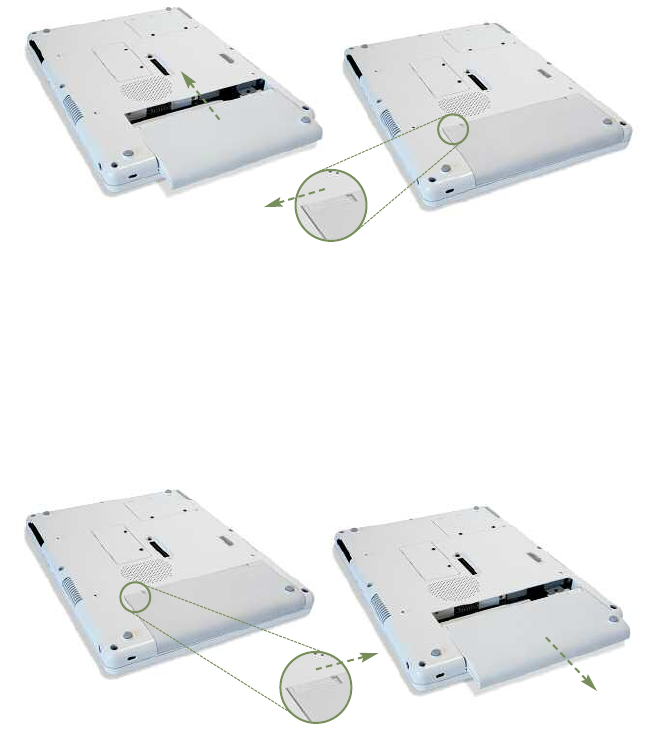
To Remove the Battery Pack
Turn off the Sahara Slate PC and remove the power cord from the
“DC Power In” port. Turn over the computer and place it on a
solid, flat surface. Slide the Locking Tab in the direction of the
arrow engraved on the tab to set it in the unlock position. Use
your other hand to slide the battery latch in the direction of the
arrow engraved on the tab and hold it there. Use both hands to
carefully side the battery out of the bay.
Step 2: Connecting the Tablet PC to an external power source
Locate the AC Adapter and the power cord. Plug the power cord
securely into the AC adapter. Plug the AC adapter’s connection
cable into the “DC Power In” port on the top of the Tablet. Once
the adapter plug is securely in place, plug the power cord into an
external power socket.
Chapter 01: Getting Started 3
Inserting the battery
Removing the battery
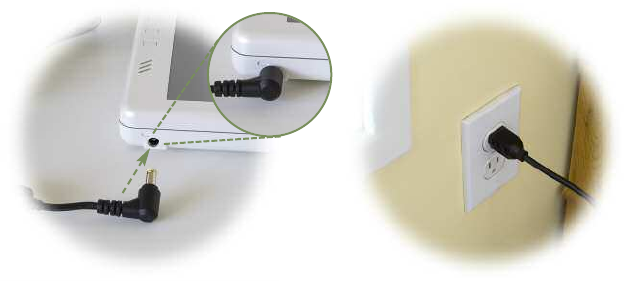
4Chapter 01: Getting Started
NOTE: When you first connect the tablet into an external power
source, the battery charge indicator will begin to glow amber. When
the battery is fully charged the indicator will turn green. (See the
section entitled Battery Care for tips on maximizing battery life and
performance.)
Step 3: Connecting applicable peripherals and networking
cables (optional)
If you have any external peripherals you’d like to use with the
tablet (i.e. USB mouse, USB keyboard, etc.) or are planning to
connect to the internet and/or corporate LAN using a wired
connection (RJ-45) as opposed to wirelessly, connect them now
(see the next section, Getting to know your Tablet PC, to identify
which ports to use).
Step 4: Powering on the Sahara Slate PC
Locate the three power switches on the top on the tablet. The
far left switch (closest to the PCMCIA Expansion slot) is the
computer’s main power toggle. Slide it toward the right side of
the unit and hold it there until it emits a blue glow (about one to
two seconds) and then release it. The Sahara Slate PC will now
boot up.
Plugging into an
external power source
!@
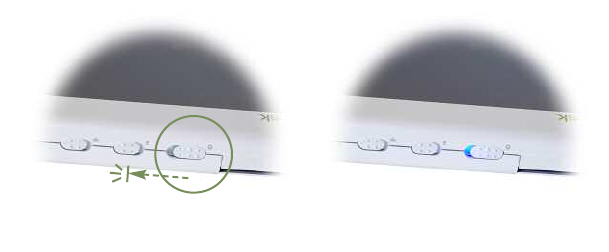
Chapter 01: Getting Started 5
Step 5: Navigating with the Stylus Pen
Unlike a standard laptop or desktop PC, standard navigational
activities are completed using the stylus pen, or even your
fingers if using the touch screen. The tablet will react to the pen
differently depending on what mode you are using.
Touch Screen mode: Navigating with a touch screen is different
than navigating with a mouse. The pen will interact with the
computer whenever you touch it to the screen.
Hold the pen as if you were writing with a standard ink pen.
Instead of sliding the pen around the screen to get to where you
are going, just tap on what you want to interact with. Sliding the
pen while lightly touching the tip to the screen will move the on-
screen pointer around similarly to if you were using a mouse and
holding down the left mouse button. In other words you would
be performing what is know as a drag operation.
Also, remember that since the screen is sensitive to touch,
resting your hand on the screen while using the pen might make
the pointer react unpredictably.
Powering on the Sahara Slate PC.
Slide and hold the toggle switch until it lights up blue.
6Chapter 01: Getting Started
TIP: When trying to select or activate something on the screen with
the stylus pen, pay attention to the position of the pointer icon
instead of the tip of the pen.
Tapping lightly on the screen will perform a standard left mouse
button click. If you want to perform a right mouse button click,
locate the <mouse icon> in the task bar and click on it. The
“Visual Mouse”window screen should appear. Clicking on the
top right box will perform the function of a right mouse button
click.
Active Digitizer mode (i440D only): In this mode (the i440D will
default to active digitizer mode when powered on for the first
time) the pen doesn’t even touch the screen to activate and
move the pointer.
Hold the pen as if you were writing with a standard ink pen.
Place the tip of the stylus just above the screen and move it
around. The pointer should follow the tip of the pen. In this
mode your hand may rest on the screen as it will not affect the
behavior of the pointer.
TIP: When trying to select or activate something on the screen with
the stylus pen, pay attention to the position of the pointer icon
instead of the tip of the pen.
Tapping lightly on the screen with the tip of the stylus will
perform a standard left mouse click. If you want to perform a
right mouse click, press and hold down the tip of the stylus
lightly on the screen. In a moment, an animated icon will draw
around the pointer. Lift the stylus from the screen to complete
the button press. (See the section Using the Stylus Pen in your
operating system’s chapter later in this manual for more
information and tips to navigating and inputting text.)

Chapter 01: Getting Started 7
This page intentionally left blank.

Chapter 02: Touring Your Sahara Slate PC 9
The Sahara Slate PC features a number of physical characteristics
designed to help you work as efficiently as possible. Take a
moment to familiarize yourself with the controls and Input/
Output (I/O) ports on the faces and sides of the computer.
Understanding the layout of the system will aid you when using
the Sahara Slate PC in the field or on the go.
Chapter 02
Touring Your Sahara Slate PC
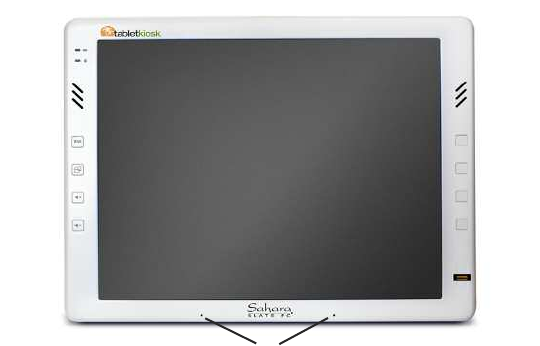
10 Chapter 02: Touring Your Sahara Slate PC
Front View
1. Battery Charge Indicator
Glows Amber when the battery is charging and changes to
green when the battery is fully charged.
2. Hard Disk Drive Activity Light
Glows amber when the hard drive is being accessed
3. Built-in Stereo Speakers
Listen to music, movies, games and more.
4. Secure Attention Sequence (SAS)
A computer without an attached keyboard must support a
hardware mechanism to generate the SAS which also known
as “CTRL-ALT-DEL” or “CAD”.
5. Screen Rotation
This button will rotate the screen counter clockwise 90º to a
portrait orientation and then back to the original landscape
orientation.
!
@
#
$
%
^
&
#
*
(
BL
BM
BN
BO
Chapter 02: Touring Your Sahara Slate PC 11
6. Volume Up
This button will increase the volume of sound emitted from
the computer’s internal speakers and headphone port.
7. Volume Down
This button will increase the volume of sound emitted from
the computer’s internal speakers and headphone port.
8. Screen Mode Toggle (i440D only)
This button will toggle the i440D’s input screen between
electromagnetic active digitizer and touch screen. This
button can be reprogrammed by the user.
8. Programmable Function Key (i412T & i440T)
This button can be programmed by the user.
9. Programmable Function Key
This button can be programmed by the user.
10. Programmable Function Key
This button can be programmed by the user.
11. Programmable Function Key
This button can be programmed by the user.
12. Finger Print Reader
Can be used to secure your system from unauthorized users.
See Securing Your Tablet PC for more information and how
to set up biometric security.
13. Dual Digital Microphone Array
Microphone array records audio with higher fidelity for more
accurate voice recognition.
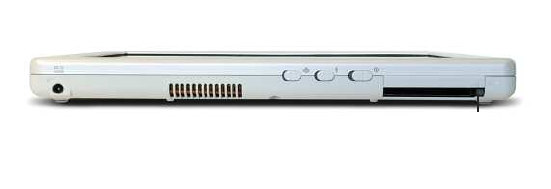
12 Chapter 02: Touring Your Sahara Slate PC
Top View
1. DC Power In Jack
Plug the AC adapter’s connection cable into this port to
provide power to the computer.
2. Ventilation Port
Fan exhaust port for expelling hot air from the interior of the
Tablet PC. Do not block to prevent over heating.
3. Wireless Networking Power Toggle
Slide toggle switch to the left to activate the wireless
networking adapter’s transmitter. The switch will glow blue
when powered on. Slide switch back to the right to turn off
wireless networking. Note: When not connected to a
wireless network, turn off to conserve battery power.
4. Bluetooth Power Toggle
Slide toggle switch to the left to activate the Bluetooth
wireless transmitter. The switch will glow blue when
powered on. Slide switch back to the right to turn Bluetooth
off. Note: When not actively using a Bluetooth peripheral,
turn off to conserve battery power.
!@#$%^&
Chapter 02: Touring Your Sahara Slate PC 13
5. System Power/Resume Toggle
Sliding this button to the right and hold for 1-2 seconds will
turn on the computer. Sliding this button while the
computer is in Suspend Mode will resume normal operation.
Sliding and holding for 4-6 seconds will immediately turn off
the computer. Note: Using this switch to power off the
computer is not recommended unless the computer has
stopped responding to user input as it allows no time for the
OS to shut down normally, and as a result, data loss may
occur.
6. PC Card (PCMCIA) Slot
Expansion port allows the connection of external
peripherals that can extend the functionality of the
computer. Compatible with standard Type I and Type II 32-
bit and 16-bit PCMCIA cards.
7. PC Card Eject Button
Use to eject a connected PC Card from the PC Card slot.
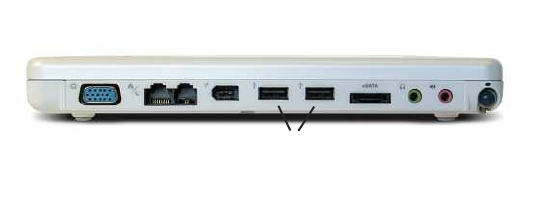
14 Chapter 02: Touring Your Sahara Slate PC
Left Side View
1. VGA Port
This port enables you to connect the Sahara Slate PC to any
external display monitor that uses a cable with a standard
male HD15 connector. Supports using the external monitor
in clone, span and dual view modes. Great for driving an LCD
or Plasma HDTV with a PC In (VGA) port.
2. LAN Port
This jack provides a standard RJ45 connection for accessing
a network or high speed internet connection via an Ethernet
cable. Supports 10/100/1000 bps protocols.
3. Modem Port
Use this RJ11 jack to connect the internal 56K voice/data/fax
modem to your phone line using a standard telephone
cable.
4. IEEE1394 (Firewire) Port
A fast external bus standard that supports isochronous data
transfer rates of up to 400 Mbps (400 million bits per
second). This makes it ideal for devices that need to transfer
high levels of data in real-time, such as video devices and
hard drives. The IEEE1394 port also supports both Plug-and-
Play and hot plugging and can supply power to lower power
peripheral devices.
!@#$ % ^&*(
Chapter 02: Touring Your Sahara Slate PC 15
5. Two USB 2.0 Ports
High speed (480 Mbs) Universal Serial Bus 2.0 ports for
connecting peripherals such as a mouse, keyboard, wedge
reader, CD/DVD drive, printer, digital camera and more.
Backwards compatible with USB 1.1 devices.
6. eSATA (External Serial Advanced Technology Attachment)
Port
With transfer speeds reaching three times that of USB 2.0 or
IEEE1394, eSATA is an excellent choice for external disk
storage. Supports both SATA II (300 Mbps) and SATA I (150
Mbps) hard drives.
7. Headphone / Audio Out
Stereo audio port for connecting headphones, external
speakers or other audio devices.
8. Audio In
Used to input stereo audio from external devices such as a
microphone, radio or tape player.
9. Stylus Pen Holder
Secures the stylus pen to the Sahara Slate PC.
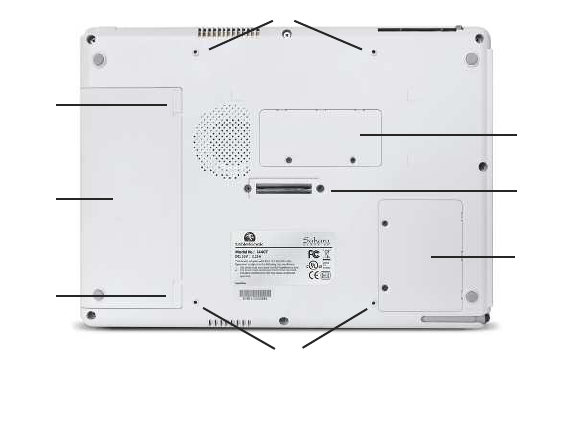
16 Chapter 02: Touring Your Sahara Slate PC
Back View
1. Wireless Networking Card Expansion Slot
Expansion slot contains wireless networking adapter. User
upgradeable.
2. RAM (Memory) Compartment
Allows access to the user upgradeable memory slot. Primary
RAM module resides on the other side of the motherboard
and is NOT user upgradeable.
3. Docking Connector
This connector will allow the use of optional VESA mounting
plate, docking station and other optional expansion devices.
4. VESA Mounting Screw Holders
Used to allow mounting with 75mm – 100mm VESA
compatible attachments.
!
@
#
$
$
%
^
&
Chapter 02: Touring Your Sahara Slate PC 17
5. Battery
The Sahara Slate PC comes equipped with a standard 6-cell
lithium ion battery pack that can be removed by the user
and replaced.
6. Battery Latch
Used along with the battery lock to release the battery from
its bay for removal.
7. Battery Lock
Allows the battery to be locked into place during use to
prevent accidental removal and subsequent power loss.
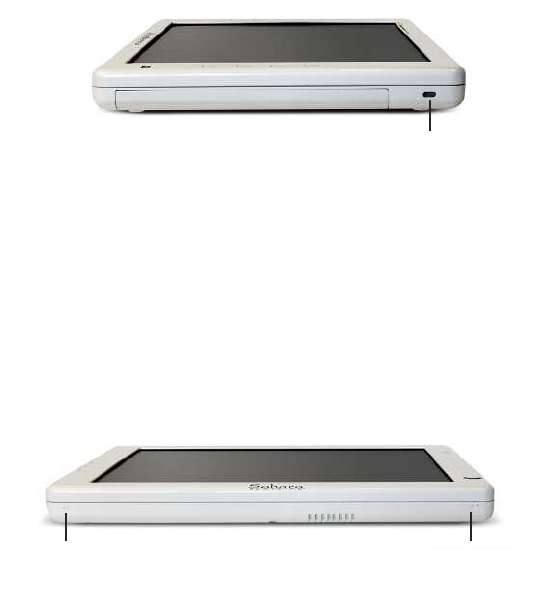
18 Chapter 02: Touring Your Sahara Slate PC
Right View
1. Anti-Theft Kensington Lock
Used with the locking device (sold separately) to attach the
Sahara Slate PC to a desk, table, kiosk, or other stationary
apparatus to help prevent the computer from being stolen.
Bottom View
1. Docking Station Support Grooves
Serves as a support and alignment guide when using the
Sahara Slate PC with the optional Docking Station.
2. Ventilation Port
Cooling fan intake port. Do not block to help prevent
overheating.
!
!!@

Chapter 02: Touring Your Sahara Slate PC 19
This page intentionally left blank.

Chapter 03: Battery Usage and Care 21
Depending on your system’s configuration and your application
usage, a fully charged battery should be able to run your Sahara
Slate PC for between 3 – 4 hours.
Operations that will significantly reduce battery life include, but
are not limited to, the following:
1. Using external bus powered optical, floppy and hard disk
drives
2. Using wireless communications devices including the
internal wireless networking card, Bluetooth adapter,
PCMCIA Cards, or USB devices.
3. Using high-brightness display settings, 3D screen savers, or
other computationally-intensive programs such as games,
media players and 3D graphics applications.
4. Running the computer in maximum performance mode.
5. Using the computer in overly hot environmental conditions.
Using the Battery for the First Time
Before using the computer on battery power for the first time,
the battery should be charged for at least four hours. Also, the
Smart Battery IC within the battery pack should be calibrated in
order to get an accurate reporting of the remaining battery life.
Chapter 03
Battery Usage and Care
22 Chapter 03: Battery Usage and Care
To calibrate the battery pack, follow these steps:
1. Turn the computer off. Connect the AC adapter and let the
battery fully recharge.
2. Disconnect the AC Adapter and Power On the computer. Let
the battery run down until it is so low that you hear
continuous warning beeps and the system automatically
enter the Suspend mode.
3. Reconnect the AC adapter, let the battery fully recharge and
then run the computer with the external power still
connected for at least five (5) continuous hours.
The battery pack should now be properly calibrated. If you find
that battery life doesn’t correspond to the battery status as
reported by your operating system, repeat steps 2 -3 again.
If after performing a calibration for a second you still find you are
having a problem with battery life, contact your dealer and
arrange for a replacement as the battery may be defective.
In general, using the battery until the “Battery Low”warning
indicator appears and then fully recharging the battery (full
discharge/charge cycle) will ensure the accuracy of the battery
status gauge.
If you find you are using the computer almost exclusively
attached to an external power source, calibrating at least once a
month is recommended.
Charging the Battery Under Typical Conditions
When you connect the computer to an electrical outlet, the
Smart Battery IC in the battery pack checks the battery’s charge
and temperature. If charging is necessary, the battery indicator
on the front of the Sahara Slate PC will glow amber and the AC
adapter will automatically charge the battery.
Chapter 03: Battery Usage and Care 23
When fully charged, the battery indicator will change to green and
the battery’s charge will be maintained while connected to the
external power source. When the computer is disconnected from
the electrical outlet, the battery indicator will turn off.
NOTE: The time to fully recharge the battery is approximately 90 –
100 minutes when the computer is powered off. The time to fully
recharge the battery when the computer is in use varies according
to the power requirements of the operations that the computer is
performing while charging.
Problems Charging the Battery
Environmental conditions can affect the ability of the computer
to charge the battery. If the battery is too hot from either being
used in your computer or being exposed to an overly hot
environment, the battery may not charge when you connect the
computer to an electrical outlet.
If this occurs, disconnect the computer from the electrical outlet
and allow it and the battery to cool to room temperature. Then
reconnect the computer to an electrical outlet to continue
charging the battery.
Battery Status
Both Windows XP and Windows Vista have an applet in the
Control Panel that will display an icon in the Windows taskbar
indicating when the computer is running on battery power or is
attached to the AC adapter.
This applet also displays a meter that indicates approximately
how much of a charge is remaining in the battery.
Low Battery Warnings
A beeping sound will be heard once to alert you to a“Battery
Low” status.
24 Chapter 03: Battery Usage and Care
When the battery’s power level drops to a “Battery Very Low”
status the beeping sound will be heard every second.
When this continuous beeping occurs, your battery has only
approximately one to two minutes of charge left. You should
save what you are working on and plug in the AC Power Adapter
to avoid potential data loss.
When there is only one minute of battery charge remaining, the
computer will suspend its current state to the hard drive and
power off. Plug in the AC Adapter and turn the computer back
on to resume your work.
About Battery Pack Usage
Over time, even with proper care, battery performance (the time
the battery can operate the computer before needing to be
recharged) will decrease. Depending on how often the battery is
used, how many times it has been charged and the conditions
under which it is used, you may need to purchase a new battery
during the life of your computer
NOTE: To avoid damage, only use replacement batteries
recommended by TabletKiosk. To prevent the loss of data when the
system loses power, do not remove the battery pack while the
power is on.
NOTE: Do not dispose of batteries with household waste. When your
battery no longer holds a charge, call your local waste disposal or
environmental agency for advice on disposing of a lithium-ion
battery.
Real Time Clock Battery
In order to maintain certain system information while the power
is off, the motherboard contains a small built-in battery pack that
constantly supplies power to the system.
Chapter 03: Battery Usage and Care 25
If the computer is left without a power source for long periods of
time, this battery can be exhausted and system information will
be lost. This will not affect any of your data stored on the
computer’s hard drive, but rather settings in the BIOS that tells
the computer how to operate. It recommended, therefore, that if
you plan to store the computer for a long time you periodically
attach the battery pack, plug in the computer to an external
power source and allow the battery to recharge.
If you find after removing the computer from storage that you
have lost this system information (you will receive a BIOS error
when you boot up for the first time) contact your dealer or visit
TabletKiosk’s website at www.tabletkiosk.com to obtain the
proper BIOS settings.
Storing a Battery
When storing your computer for an extended period of time, it is
recommended that you remove the battery pack and store it in a
dry, cool location. Since a battery discharges during prolonged
storage, you should fully recharge the battery before you use it
again.
This page intentionally left blank.

Chapter 04: Upgrading Your Sahara Slate PC 27
Out of the box, your new Sahara Slate PC is a powerful, mobile
companion capable of accomplishing a wide variety of tasks
with speed and precision. Depending on your system’s
configuration, there are still ways to make your Tablet PC do
more and do it faster.
This chapter will focus on the procedures for upgrading, and/or
replacing, your computer’s memory (RAM), storage capacity
(hard disk drive) and wireless networking card.
Before you Begin ANY Upgrade Procedure
Before attempting to add or remove any components within the
Sahara Slate PC it is important that you always observe the
following conditions/procedures:
1. The computer should be powered off, the power cable
should be removed from the computer and the battery
should be removed. (Refer to the section, To Remove the
Battery Pack)
2. Any networking, modem and cables connected to other
powered devices should be disconnected.
3. When disconnecting a cable from the computer, always pull
on its connector, not on the cable itself. When reconnecting
a cable, ensure that both the connector and corresponding
pins are aligned properly with the cable before attempting
to secure it in place.
Chapter 04
Upgrading Your Sahara Slate PC
28 Chapter 04: Upgrading Your Sahara Slate PC
4. All components should be handled with care. Do not touch
the components or contacts on the cards or underside of the
drives. Always hold such components by the edges or sides.
5. All electronic components inside a computer are sensitive to
electrostatic discharges. It is therefore important that you
properly ground yourself before attempting any of the
following procedures either by using a wrist grounding strap
or by periodically touching an exposed, unpainted metal
surface.
6. You should only attempt upgrades and/or component
replacements on a solid, clean, flat surface.
CAUTION: Damage resulting from the servicing of your computer
that is not authorized by TabletKiosk is not covered by your
computer’s standard or optional extended warranty.
Upgrading Memory (RAM)
You can increase your tablet’s memory by installing a RAM
(Random Access Memory) module on the computer’s system
board. Typically, the more RAM your computer has the better it
will perform, especially when running multiple tasks or
applications simultaneously.
Your Sahara Slate PC can accommodate two RAM modules. The
primary module is factory installed on the motherboard
underneath the display screen and cannot be upgraded by the
user without voiding your computer’s warranty. If you would like
to upgrade this module, contact your dealer for instructions on
sending your system in for service. The secondary module is
located in the RAM compartment that is accessible on the back
panel of the computer.
Refer to the following instructions and illustrations for
information on how to upgrade your computer’s secondary

Chapter 04: Upgrading Your Sahara Slate PC 29
memory module. Be sure to follow the procedures
in the preceding section, Before you Begin
ANY Upgrade Procedure.
1. Turn off your computer, turn it
over and place it face down on
a solid, flat surface. Be careful
not to place it on something
rough that could damage the
display screen.
2. Locate the RAM module
compartment near the center of
the back panel of the system.
Loosen the two screws that
secure the RAM module
compartment cover.
3. Lift the cover from the edge
where the screw holes are located
to remove it and set it aside. Inside is
the RAM slot. Depending upon
your system’s configuration, it
will either be empty or
populated with an existing
module.
4. If it is empty, proceed to step 6,
otherwise, using your fingers or a
small screwdriver, press the two
plastic tabs on the sides of the RAM
module away from the module.
The top edge of the RAM
module should pop up slightly.
5. Gently pull out the RAM module
as shown in the illustration.
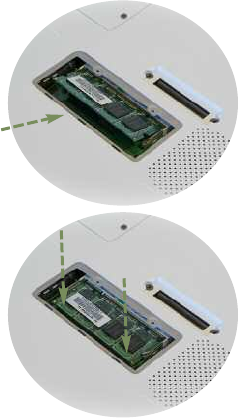
30 Chapter 04: Upgrading Your Sahara Slate PC
6. To insert a new RAM module,
align the connector pins on the
bottom of the RAM module
with the RAM module socket
and slide the module into the
socket. Once properly inserted
in the socket, press the RAM
module down until it clicks into
place.
7. Replace the cover on this
compartment and then
replace and tighten the
screws.
NOTE: Your Sahara Slate PC supports
dual channel RAM. In order to take
advantage of this higher bandwidth
feature, you’ll need to install a memory
module that matches the primary module installed on the other
side of the motherboard at the factory. Check with your dealer if
you are unsure what module your system currently has installed.
Upgrading the Hard Disk Drive (HDD)
The computer’s HDD is the storage facility that holds all the files
on your computer. If you find you are running out of space, you
might consider upgrading to a larger drive.
Typically when a computer’s HDD fills up, its access time begins
to increase and your system will seem to slow down. When this
occurs, upgrading to a larger drive often will equate to better
performance.
Your Sahara Slate PC comes pre-configured with a HDD that is
easy to upgrade. Before installing a new hard drive, however, be
sure to back up all of the files on your existing drive.
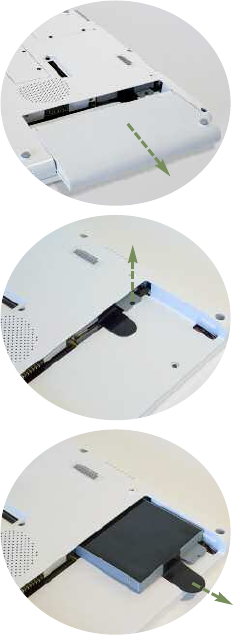
Chapter 04: Upgrading Your Sahara Slate PC 31
Refer to the following instructions and illustrations for
information on how to upgrade your computer’s HDD. Be sure to
follow the procedures in the preceding section,
Before you Begin ANY Upgrade Procedure.
1. Turn off your computer, turn it
over and place it face down on a
solid, flat surface. Be careful not
to place it on something rough
that could damage the display
screen.
2. With the battery removed, look
inside the battery compartment and
you will see a black plastic strip
sitting next to a metal tab held in
place by a single screw. Remove
the screw from the metal tab
and place it somewhere safe.
3. Take hold of the plastic HDD
release strip and gently pull the
HDD out of its compartment as shown
in the illustration.
4. Unscrew the existing drive from
its cage and replace it with the
new HDD. Once you have
secured the new drive into the
cage with the screws, slide it back
into the HDD compartment.
5. Replace the screw into the metal tab that
holds the drive cage in place.
6. After the HDD is securely inserted, you can insert the battery
back into the battery compartment.
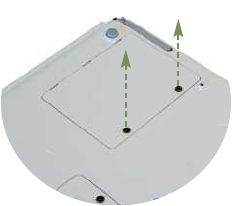
32 Chapter 04: Upgrading Your Sahara Slate PC
Replacing the Wireless Networking Card (Advanced)
Currently there are three standard wireless networking
protocols, 802.11a/802.11b/ 802.11g, that are widely used and
offer various capabilities and ranges. Right on the horizon is a
third, 802.11n, which promises higher throughput and a longer
operational range.
The Sahara Slate PC was built with this new, impending standard
in mind, and features a user upgradeable wireless networking
adapter. It should be mentioned, however, that while replacing
the wireless card isn’t difficult, it is a more delicate and involved
procedure than upgrading the RAM or HDD. If you are
uncomfortable performing this upgrade yourself, please contact
your dealer to arrange for it to be upgraded at their facility.
Refer to the following instructions and illustrations for
information on how to upgrade your computer’s wireless
networking adapter. Be sure to follow the procedures in the
preceding section, Before you Begin ANY Upgrade Procedure.
1. Turn off your computer, turn it over and place it face down
on a solid, flat surface. Be careful not to place it on
something rough that could damage the display screen.
2. Locate the wireless networking adapter’s
compartment near the right side of
the back panel of the system, just
above the stylus pen holder.
Loosen the two screws that
secure the wireless
compartment cover.
3. Lift the cover from the edge
where the screw holes are located
to remove it and set it aside. Inside is
the wireless networking adapter, 56K
voice/data/fax modem and Bluetooth® adapter. The wireless
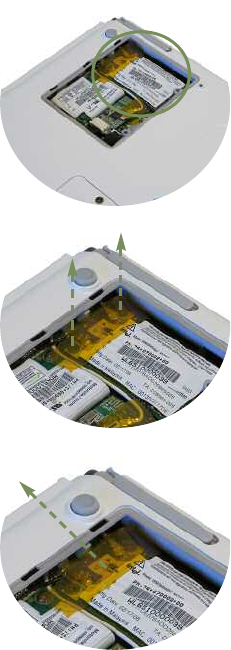
Chapter 04: Upgrading Your Sahara Slate PC 33
adapter is located at the bottom of the slot
and is seated inside a small slot
connector.
4. The wireless card is held in place
by two small screws. First,
carefully remove the yellow
tape covering the screws and
antenna leads. Then remove the
screws and set them aside in a
safe place. Once the screws are
removed, the card will pop up
slightly.
5. Carefully, slide the card out of
the slot. Be sure to unscrew the
antenna leads from the card
before fully removing the card
from the interior of the
compartment.
6. Take the new wireless networking
card you obtained from your
dealer and carefully align it into
the connector slot. Attach the
antenna leads to the card
before inserting it fully into the
compartment.
7. Once the leads are connected,
press downward on the card to push it
into position and replace the screws to hold
the card in place.
8. Replace the tape over the screws and antenna leads and
replace the cover and tighten the screws that hold the cover
in place.
This page intentionally left blank.

Chapter 05: Troubleshooting 35
This chapter describes some techniques for locating information
and solving problems that you may encounter while using your
Sahara Slate PC. If you find, after reading this section, you are
unable to solve a problem you are having, please check out more
online resources at www.tabletkiosk.com or contact the
Authorized Dealer where you purchased your Tablet PC (see the
section below, Contacting Your Dealer for a list of the
information you’ll need to supply them).
General Hardware Problems / Possible Causes and Solutions
A few common hardware problems and suggested solutions are
presented in the tables below:
Audio Problems/Solutions
Problem Possible Cause Solution
No sound can be
heard.
Either the volume is
muted or turned
down.
Use the Microsoft Windows volume
control icon at the lower right hand
corner of the display to adjust the
volume and disable muting.
No sound can be
heard through
external speakers or
headphones.
Connected to the
wrong jack.
Make sure to change the connector to
the proper jack.
Speakers aren’t
powered on.
Check to make sure the speakers are
plugged in and turned on.
Chapter 05
Troubleshooting

36 Chapter 05: Troubleshooting
Battery Problems/Solutions
Internet Problems/Solutions
Problem Possible Cause Solution
The computer is
unable to connect to
the Internet.
Account for Internet
service provider (ISP)
is not properly
configured.
Ask for your ISP assistance.
No valid network
connection detected.
Check the status bar to make sure you
are connected to a valid network. If not,
rerun your OS’s network set-up wizard.
If connecting
wirelessly, wireless
card is turned off.
Look at wireless power toggle on the
top of the Tablet to make sure it is
switched on.
Problem Possible Cause Solution
Beeping sound. The computer’s
battery is low and
Hibernation Mode is
disabled.
Connect the computer to an external
power source immediately.
The battery pack is
warm after charging.
This is a normal
condition.
No action is required.
The battery LED
indicator does not
light whether the
battery is charging or
not.
No power is
connected to the
computer.
Check the power source.
The battery is fully
charged.
Refer to the battery icon located at the
lower right hand corner of your screen
if you are operating on battery power.
Battery pack was
exposed to a high
temperature.
Let the battery pack reach room
temperature before attempting to
charge again.
The battery pack is
nearing the end of its
life.
Replace the battery pack. Use only
batteries recommended for use with
your specific model.
Battery charge gauge
is not accurately
displaying the charge
remaining
Battery pack requires
calibration.
Calibrate the battery pack.

Chapter 05: Troubleshooting 37
Networking Problems/Solutions
Power Problems/Solutions
Problem Possible Cause Solution
The computer is
connected to an
external power source
but does not turn on
even though the
battery pack is
connected.
The battery pack may
be defective.
Replace the battery pack.
The Power/Standby
light is off and the
system turns off when
it is left unattended.
The system initiated
Hibernation mode
Slide the Power toggle switch to the
right and hold for a second to resume.
The system will not
turn on after it turns
off when left
unattended.
The system initiated
Hibernation because
it is in a critical low-
battery condition.
Connect the computer to an external
power source.
Problem Possible Cause Solution
The system does not
connect to the
network
The settings are not
correctly set.
Contact your network administrator.
If connecting
wirelessly, wireless
card is turned off.
Look at wireless power toggle on the
top of the Tablet to make sure it is
switched on.

38 Chapter 05: Troubleshooting
Screen Display Problems/Solutions
USB Problems/Solutions
Problem Possible Cause Solution
An external device
does not work when
connected to one of
the USB ports.
The external device is
not receiving power.
Ensure that the external device is
plugged into an electrical outlet.
The external device is
defective.
Try connecting the external device to
another computer to determine if it
operates properly.
Windows isn’t
recognizing the
device properly.
Disconnect the device, power it off,
reconnect the device and then turn it
on.
Disconnect the device, power it off,
power it back on and then plug it back
in to the computer.
Problem Possible Cause Solution
The screen is blank. Standby or Hibernate
has initiated.
Slide the Power toggle switch to the
right and hold for a second to resume.
External monitor
display is selected
Check the external display and use the
VGA utility to change back the primary
display to the Tablet’s internal screen.
The mouse pointer
won’t follow the stylus
pen properly.
Calibration is off. Rerun the calibration routine in the
TouchSet application.
The screen won’t
rotate when the
screen rotation button
is pressed.
VGA driver is not set
for rotation support.
Use the Intel VGA Utilities to enable the
screen rotation option.
VGA drivers are
corrupted.
This can happen over time. Check the
website to make sure you have the
newest available drivers, then uninstall
the current drivers and install the new
drivers.

Chapter 05: Troubleshooting 39
Upgrade Problems/Solutions
Problem Possible Cause Solution
After upgrading the
computer’s RAM, the
system does not boot
up properly
The RAM module is
not seated properly.
Following the instructions in the section
entitled Upgrading Your Memory, try
removing and reseating the RAM
module.
The RAM module is
defective.
If reseating the module from the above
step does not solve the problem, the
RAM module could be defective.
Contact your dealer for assistance.
After upgrading the
computer’s RAM the
system begins
crashing, seemingly at
random intervals.
The RAM module is
not seated properly.
Following the instructions in the section
entitled Upgrading Your Memory, try
removing and reseating the RAM
module.
The RAM module is
defective.
If reseating the module from the above
step does not solve the problem, the
RAM module could be defective. First
remove the RAM module and begin
using your computer to make sure that
nothing else is causing the crashes. If
your system seems to be running
Contact your dealer for assistance.
After replacing the
HDD the system
cannot boot into your
Operating System.
Drive isn’t formatted. Restart the system with an external
CD/DVD drive attached and have the
System Restore Disc that came with
your computer inserted in the drive.
Drive isn’t connected
properly.
Following the instructions in the section
entitled Upgrading the Hard Disk Drive
(HDD), try reseating the HDD in the bay.
NOTE : If your Table-PC doesn't have the wireless card.
When you wanted to addition wireless card , you must choose the
certificated wireless card (Type: INTEL PRO/Wireless 3945ABG).
40 Chapter 05: Troubleshooting
Contacting Your Dealer
If you still have a problem after reading the preceding section,
the next step is to contact your dealer where you purchased your
Sahara Slate PC.
Your dealer can determine if the problem will require that the
computer be taken to a service center for repair. Before you call
your dealer, however, please have the following information
available:
1. Which model do you have?
2. What is the serial number?
3. How is your computer configured? What peripheral devices
you are using.
4. What messages, if any, are on the screen?
5. What software were you running at the time of the problem?
6. What have you done already to try to solve the problem? If
you have overlooked a step, your dealer may be able to
solve the problem over the phone.

Chapter 05: Troubleshooting 41
This page intentionally left blank.

Appendix A: Specifications 43
Processor
i412T:
Intel® Celeron® M ULV 423
1.06 GHz, 32KB/32KB L1 cache, 1 MB L2 cache,
533 MHz Front Side Bus (FSB)
Intel Enhanced SpeedStep® Technology
i440D and i440T:
Intel® Core™ Duo LV L2500
2 CPU Cores @ 1.83 GHz
32KB/32KB L1 cache, 2 MB shared L2 cache,
667 MHz FSB
Intel® Virtualization Technology
Enhanced Intel SpeedStep® Technology
Chipsets
Intel® 945 GM Express North Bridge with 533 MHz and
667 MHz FSB Support
Intel® ICH7-M South Bridge with 10 GB/s full duplex
DMI, PCI Express 1.0a
ACPI 1.0b and 2.0 Compliant, supports C0-C4, S0, S3-S5
power states, Intel® SpeedStep® Technology
Appendix A
Specifications
44 Appendix A: Specifications
Memory
2x SODIMM DDR2 (Unbuffered, 64-bits/channel) slots
with initial configurations of 512 MB - 2.0 GB
Upgradeable to 4.0 GB with 2.0 GB SODIMMs
(modules available Q2 2007)
Supports Single Channel, Dual Channel Symmetric, or
Dual Channel Asymmetric DDR2 Configurations
Supports Reduced Power DDR2 (RPDDR2)
Intel® Rapid Memory Power Management
Battery
Rechargeable 6-Cell Lithium Ion Smart Battery Pack
(3800 mAh @ 11.1 V, 42W/hr)
Over Charge Protection, Over Discharge Protection,
Over Current and Output Short Protection, Over
Thermal Protection
Hard Drive
2.5" 9.5 mm, Ultra DMA SATA 150gb
Configurations from 60 GB to 160 GB @ 5,400 rpm
Configurations from 60 GB to 100 GB @ 7,200 rpm
Video
Intel® GMA 950 PCI Express, 250 MHz Core Render Clock
at 1.05V core
DirectX 9.1 Compatible, Intel® Dual Frequency Graphics
Technology, Intel® Dynamic Video Memory Technology
3.0
Intel® Smart 2D Display Technology, High Performance
MPEG-2 Decoding, VLD/iDCT Hardware Acceleration
Screen rotates 0°, 90° ,The degree180 or 270 is disabled.
1024 x 768 Landscape, 768 x 1024 Portrait
Appendix A: Specifications 45
Dual Display Support
External Display up to QXGA (2048 x 1536) with CRT Hot
Plug support
Display
12.1" TFT XGA LCD Wide Angle Display
i412T and i440T:
Passive Resistive Touch Screen
i440D:
Dual Mode Active Digitizer and Touch Screen, Hot Mode
Switchable
Outdoor Viewable Screen (Optional)
Audio
Intel® High Definition Audio Interface (ICH7-M)
Independent Bus Master Logic for eight (8) general
purpose streams: 4 in / 4 out
ALC262-VC2-GR HD Codec
AC '97 Compatible
Multichannel 32-bit / 44.1KHz/48KHz/96KHz/192KHz
sampling rate output (DAC)
Multichannel 32-bit / 44.1KHz/48KHz/96KHz sampling
rate input (ADC)
Built-in Stereo Speakers and Dual Digital Microphone
Array for added fidelity and accuracy
3.5 mm Headphone & Microphone Plug 'n Play Jacks
Wireless
Intel® Pro 3945 Dual-Band/Tri-Mode 802.11 a/b/g
Networking with Power ON/OFF Switch
46 Appendix A: Specifications
64-bit and 128-bit WEP Encryption, Hardware AES (128-
bit, 192-bit, 256-bit key sizes)
Supports IEEE 802.11 Power Save Protocol (PSP)
Bluetooth® 2.0+EDR built-in USB module with Power
ON/OFF Switch
Finger Print Reader
Patented TruePrint Technology for best Ability to
Acquire (ATA)
High Definition 128x8 TruePrint Technology based
pixels
6.5mm x .40mm 500 pixel per inch array
USB 2.0 High Speed interface with Suspend and Remote
Wake-up
Full Support for C3 Selective Suspend Mode
Built-in Low Power Finger Detection with Remote Wake-
up capability
TPM Security
Single-Chip Trusted Platform Module (TPM)
Embedded TPM 2.1 Firmware
TPM Administration Tool provides Owners/Users
Management and Key Archive Policies
Trusted Group Computing (TCG) v1.1B / v1.2
configurable mode of operations
Expansion Slot
PCMCIA 2.1 Compliant, Supports one (1) Type II 32-bit
PC Card Bus Architecture
Appendix A: Specifications 47
I/O Ports
1x RJ-11 56Kbps v.90 Fax/Modem
1x RJ-45 10/100/1000 Mbps Full Duplex (2.5 Gbps
single-lane channel) Ethernet
2x USB 2.0
1x IEEE 1394a, 6-pin
1x eSATA
1x DC-In
1x 3.5mm Audio Out, 1x 3.5mm Audio In
1x VGA port, HD15
1x Cradle Connector
Weight
1.49 kg (3.3 lbs.) with Battery Pack Installed
Measurements
11.81 in x 9.45 in x .98 in (300 mm x 240 mm x 25 mm)
Color
White or Black
LED Indicators
Power (ON: blue, Standby: blinking)
Battery (Charging: amber, Low: amber blinking, Fully
charged with DC connected: blue)
Hard Drive (Activity: blue blinking)
Wireless Networking (Active: blue)
Bluetooth (Active: blue)
48 Appendix A: Specifications
Function Buttons (L)
SAS (Ctrl+Alt+Del)
Screen Rotation
Volume Up
Volume Down
Function Buttons (R)
Digitzer/Touch Screen Mode Switch (i440D only) and
User Programmable
User Programmable
User Programmable
User Programmable
Control Switches
Power Switch
Wireless On/Off
Bluetooth On/Off
Finger Print Reader
Lead-Free 40 Ball Grid Array (BGA) Package
Ultra-Hard Wearing Surface Coating is scratch and
impact resistant
Rated for over 10 million rubs without degradation
0°C to +70°C Operating Temperature Range
IEC 61000-4-2 Level 4 ESD Immunity (+/- 15KV)
Appendix A: Specifications 49
AC Adapter
100~240V, AC 47~63 Hz, 20V DC output, 3.25A, 65W
adapter
SCP: Short Circuit Protection plus Auto-Recovery
Function
OVP: Over-Voltage Protection, Latch Mode, up to
27.0Vdc maximum
OCP: Over-Current Protection, Auto-Recovery, up to
5.5A maximum
OTP: Over-Temperature Protection to prevent
catastrophic failure from overheating.
Operating Environment
Temperature: 5°C ~ 35°C (41°F ~ 95°F)
Humidity: 20% ~ 80% (no condensation)
This page intentionally left blank.
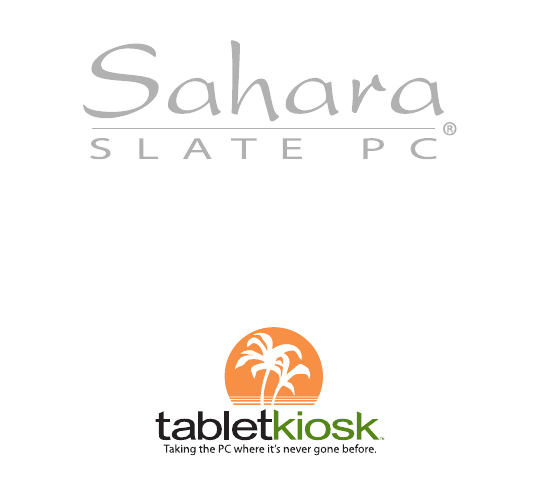
386 Beech Avenue, Suite 6, Torrance, CA 90501
310 782 1201 tel 310 782 1205 fax
www.tabletkiosk.com
UG.SG22.Rev 002FCC.3.14.07